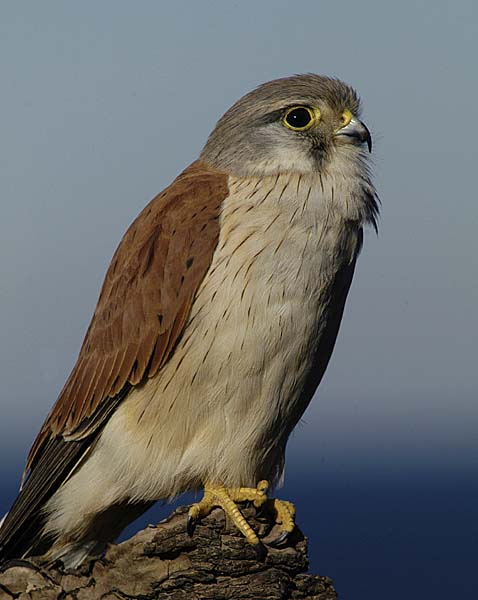(Video link) |
|||
| (5 intermediate revisions by 2 users not shown) | |||
| Line 1: | Line 1: | ||
'''Alternative name: Nankeen Kestrel''' | '''Alternative name: Nankeen Kestrel''' | ||
| − | [[Image:Australian_Kestrel.jpg|thumb|550px|right|Male Australian Kestrel<br>Photo by {{user|Neil|Neil}}<br>[[Sydney]], [[Australia]]]] | + | [[Image:Australian_Kestrel.jpg|thumb|550px|right|Male Australian Kestrel<br />Photo by {{user|Neil|Neil}}<br />[[Sydney]], [[Australia]]]] |
;[[:Category:Falco|Falco]] cenchroides | ;[[:Category:Falco|Falco]] cenchroides | ||
| − | |||
==Identification== | ==Identification== | ||
| − | + | 31cm (Male) to 35 cm (female).<br /> | |
| − | + | Rufous or brown above, white or off-white below, black tail tip<br /> | |
| + | '''Male''': grey head and tail <br /> | ||
| + | '''Female''': pale rufous head and paler rufous tail and has blackspot in each feather. | ||
==Distribution== | ==Distribution== | ||
[[Australia]], [[New Guinea]], and nearby islands. | [[Australia]], [[New Guinea]], and nearby islands. | ||
| − | |||
==Taxonomy== | ==Taxonomy== | ||
| + | ====Subspecies<sup>[[#References|[1]]]</sup>==== | ||
| + | [[Image:Kestrel IMG 1771cx.jpg|thumb|350px|right|Female<br />Photo by {{user|davidfree|davidfree}}<br />Cottesloe, [[Western Australia]], July 2008]] | ||
There are 2 subspecies; | There are 2 subspecies; | ||
| − | * ''F c cenchroides'' | + | *''F. c. cenchroides'': |
| − | * ''F c baru'' | + | :*[[Australia|Australian]] region; winters [[New Guinea]] to [[Java]] and [[Moluccas]] |
| − | + | *''F. c. baru'': | |
| + | :*Montane forests of west-central [[New Guinea]] | ||
==Habitat== | ==Habitat== | ||
| − | Temperate grasslands and open woodlands, coastal cliffs and dunes, towns and cities. Possibly the most widely recorded bird in Australia | + | Temperate grasslands and open woodlands, coastal cliffs and dunes, towns and cities. Often seen on telegraph poles or dead trees. Possibly the most widely recorded bird in Australia |
| − | |||
==Behaviour== | ==Behaviour== | ||
| + | ====Diet==== | ||
The diet includes insects, small birds and reptiles and mice. | The diet includes insects, small birds and reptiles and mice. | ||
| − | + | [[Image:IMG 3065.jpg|thumb|350px|right|Photo by {{user|jimmclean|jimmclean}}<br />[[Royal National Park]], [[New South Wales]], [[Australia]], March 2008]] | |
| − | They nest in a tree hollow, cliff ledge or disused corvid's nest; 3-7 eggs are laid and are incubated by the female | + | ====Breeding==== |
| − | + | They nest in a tree hollow, cliff ledge or disused corvid's nest; 3-7 eggs are laid and are incubated by the female for 26 to 28 days. The male brings food. | |
==References== | ==References== | ||
| − | Wikipedia | + | #{{Ref-Clements6thDec08}}#Wikipedia |
| − | The Slater Field Guide to Australian Birds | + | #The Slater Field Guide to Australian Birds |
| − | + | {{ref}} | |
==External Links== | ==External Links== | ||
{{GSearch|Falco+cenchroides}} | {{GSearch|Falco+cenchroides}} | ||
| − | [[Category:Birds]][[Category:Falco]] | + | <br /> |
| + | {{Video|Australian_Kestrel}} | ||
| + | [[Category:Birds]][[Category:Falco]] [[Category:Videos]] | ||
Revision as of 20:33, 31 May 2010
Alternative name: Nankeen Kestrel
- Falco cenchroides
Identification
31cm (Male) to 35 cm (female).
Rufous or brown above, white or off-white below, black tail tip
Male: grey head and tail
Female: pale rufous head and paler rufous tail and has blackspot in each feather.
Distribution
Australia, New Guinea, and nearby islands.
Taxonomy
Subspecies[1]
There are 2 subspecies;
- F. c. cenchroides:
- Australian region; winters New Guinea to Java and Moluccas
- F. c. baru:
- Montane forests of west-central New Guinea
Habitat
Temperate grasslands and open woodlands, coastal cliffs and dunes, towns and cities. Often seen on telegraph poles or dead trees. Possibly the most widely recorded bird in Australia
Behaviour
Diet
The diet includes insects, small birds and reptiles and mice.
Breeding
They nest in a tree hollow, cliff ledge or disused corvid's nest; 3-7 eggs are laid and are incubated by the female for 26 to 28 days. The male brings food.
References
- Clements, JF. 2008. The Clements Checklist of Birds of the World. 6th ed., with updates to December 2008. Ithaca: Cornell Univ. Press. ISBN 978-0801445019.
- Wikipedia
- The Slater Field Guide to Australian Birds
Recommended Citation
- BirdForum Opus contributors. (2024) Nankeen Kestrel. In: BirdForum, the forum for wild birds and birding. Retrieved 16 April 2024 from https://www.birdforum.net/opus/Nankeen_Kestrel
External Links






